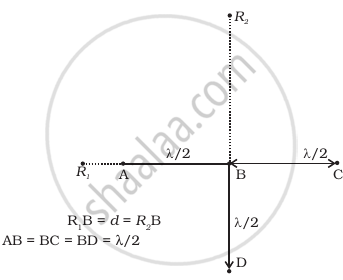Advertisements
Advertisements
Question
Two wavelengths of sodium light 590 nm and 596 nm are used, in turn to study the diffraction taking place at a single slit of aperture 2 × 10−4m. The distance between the slit and the screen is 1.5 m. Calculate the separation between the positions of the first maxima of the diffraction pattern obtained in the two cases.
Solution
Given that: Wavelength of the light beam, λ1 = 590 nm = 5.9 ×10-7 m
Wavelength of another light beam, λ2 = 596 nm = 5.96 ×10-7 m
Distance of the slits from the screen = D = 1.5 m
Distance between the two slits = a = 2 ×10-4 m
For the first secondary maxima, `sin θ = (3λ_1)/(2a) = x_1/D`
or
`x_1 = (3λ_1D)/(2a) and x_2 = (3λ_2D)/(2a)`
∴ Spacing between the positions of first secondary maxima of two sodium lines `x_1 -x_2 = (3D)/(2a)(λ_2 -λ_1) = 6.75 xx 10^-5m`
RELATED QUESTIONS
A point is situated at 7cm and 7·2 cm from two coherent sources. Find the· nature of illumination at the point if wavelength of light is 4000A.
Show graphically the intensity distribution in Fraunhofer's single slit diffraction experiment. Label the axes.
Monochromatic light of wavelength 4300 Å falls on a slit of width ‘a’. For what value of ‘a’ the first maximum falls at 30° ?
What should be the order of obstacle or aperture for diffraction of light?
Diffraction effects are easy to notice in the case of sound waves than in case of light waves because
Direction of the first secondary maximum in the Fraunhoffer diffraction pattern at a single slit is given by (a is the width of the slit):
A polariod (I) is placed in front of a monochromatic source. Another polatiod (II) is placed in front of this polaroid (I) and rotated till no light passes. A third polaroid (III) is now placed in between (I) and (II). In this case, will light emerge from (II). Explain.
Four identical monochromatic sources A, B, C, D as shown in the (Figure) produce waves of the same wavelength λ and are coherent. Two receiver R1 and R2 are at great but equal distances from B.
- Which of the two receivers picks up the larger signal?
- Which of the two receivers picks up the larger signal when B is turned off?
- Which of the two receivers picks up the larger signal when D is turned off?
- Which of the two receivers can distinguish which of the sources B or D has been turned off?

How can you differentiate whether a pattern is produced by a single slit or double slit?
In a diffraction pattern due to a single slit, how will the angular width of the central maximum change, if the slit width is decreased?
Justify your answer.
